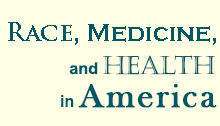Education
Higher Education Module
Race, Medicine, and Health in America
About the Module
Author
Richard M. Mizelle, Jr. is an Associate Professor of History at the University of Houston and the author of Backwater Blues: The Mississippi Flood of 1927 in the African American Imagination (Minneapolis: University of Minnesota Press, 2014) and co-editor of Resilience and Opportunity: Lessons from the U.S. Gulf Coast after Katrina and Rita (Washington, DC: Brookings Institution Press, 2012). Since 2015, Dr. Mizelle has focused on research and writing a history of race and diabetes from the turn of the twentieth-century to Hurricane Katrina. Trained as an historian of medicine, race, environment, and technology his research and teaching pushes the boundaries and intersections of these fields of study.
Suggested use
The Race, Medicine, and Health in America module is designed to introduce students to the intersecting narratives of race, environment, and health through the use of selected case studies: including lead poisoning, asthma, the Environmental Injustice Movement, the 1995 Chicago Heat Wave, and Hurricane Katrina. The case studies were chosen because they do not fit neatly into medical history or the history of race or environmental history, but instead create opportunities to think critically about the cross-pollination of intellectual ideas and concepts of analyzing the historical past. Therefore, this module is designed for educators interested in making broad connections between fields in the classroom. Instructors interested in the history of medicine, for instance, might bring to bear how environmental vulnerabilities of lead poisoning and asthma were created by systematic inequality and racism. These are points raised in the works of Gerald Markowitz and David Rosner, as well as Gregg Mitman. Alternatively, instructors interested in the history of race or environmental history might think about Eric Klinenberg’s book on the 1995 Chicago Heat Wave that frames the disaster through the lens of historically vulnerable populations living in vulnerable spaces that ultimately resulted in the inability to withstand this particular environmental disaster. Ultimately this module provides a broad template for thinking about fields that scholars often conceptualize separately, but overlap considerably in teaching and research.
The primary source materials and secondary readings serve as the foundation for class discussion and the exploration of research topics by students. For example, while many students have heard of lead poisoning, they are often unaware of the long and contentious history of this Earth’s metal and the fact that it still presents a significant public health conundrum today. The module pays particular attention to our ability or inability to control environments. The readings, primary sources, and questions push students to think about why poor people and minorities suffer the most from environmental contaminants, asthma, and environmental disasters. For instance, asthma is a complex social and biological disease which mean that questions of housing, poverty, work, place, and access are just as important as what occurs inside the physical body. Strictly bio-medical interpretations of asthma, historically and today, would unduly minimize the environmental and structural dimensions that make this disease so complicated.
Objectives
At the conclusion of a unit or an entire module, students are expected to:
- Demonstrate an ability to critically analyze both primary and secondary sources.
- Discuss how race intersects with environment and medicine.
- Identify key environmental and health stressors and the ways in which racism impacts historical experiences.
- Describe the origins of the Environmental Injustice Movement and health, particularly the reasons why groups of people are circumscribed into dangerous locations and places.
- Analyze the ethics of healthcare and research using lead poisoning as a framework.
- Draw on the literature to think about disasters, environmental history, and health.


